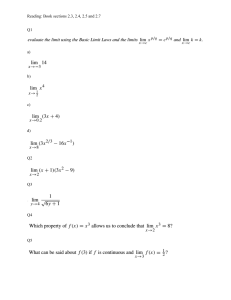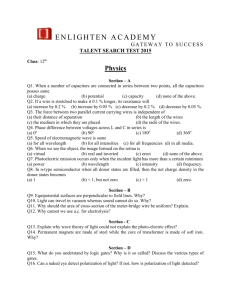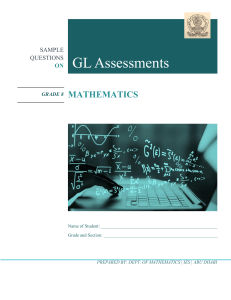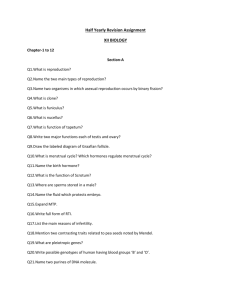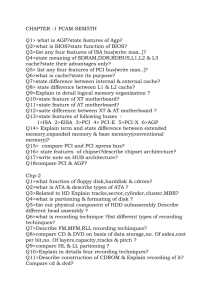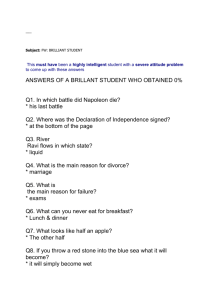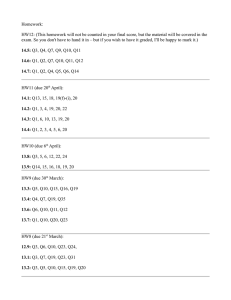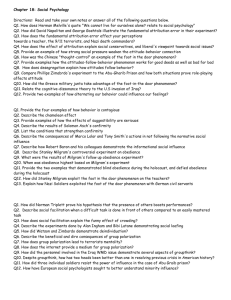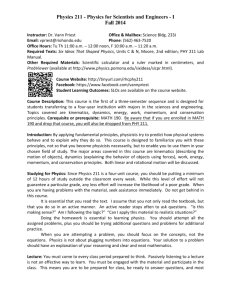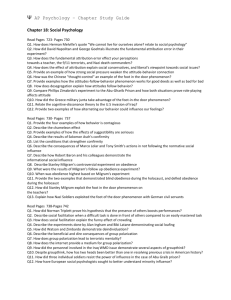Physics 212 Physics for Scientists and Engineers
advertisement
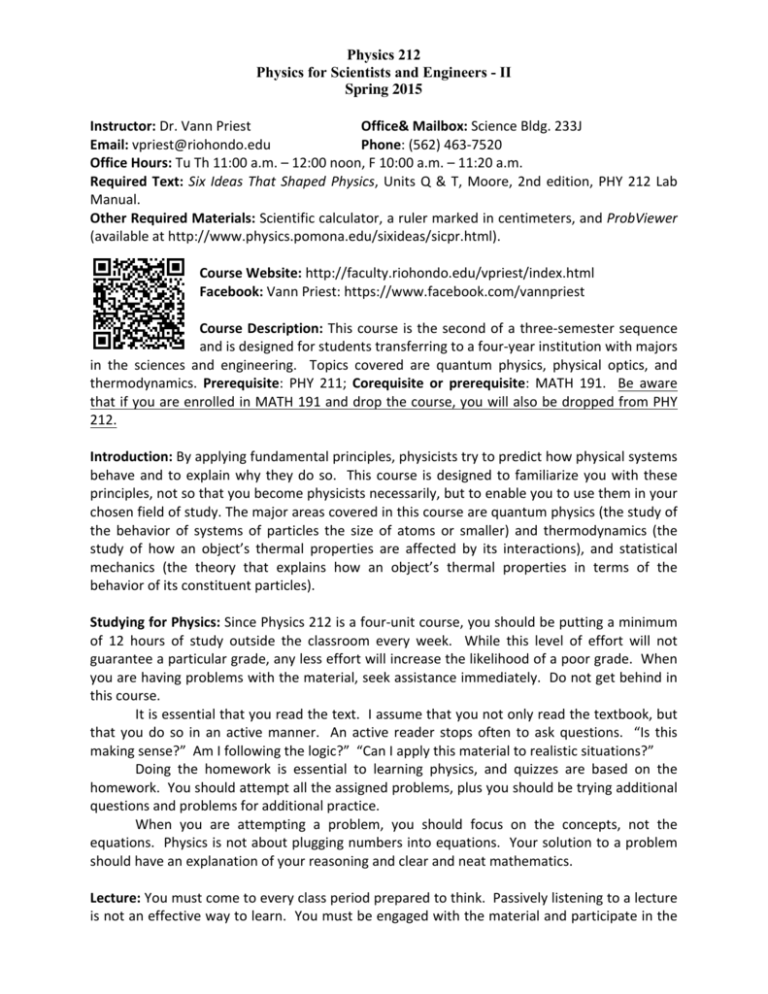
Physics 212 Physics for Scientists and Engineers - II Spring 2015 Instructor: Dr. Vann Priest Office& Mailbox: Science Bldg. 233J Email: vpriest@riohondo.edu Phone: (562) 463-­‐7520 Office Hours: Tu Th 11:00 a.m. – 12:00 noon, F 10:00 a.m. – 11:20 a.m. Required Text: Six Ideas That Shaped Physics, Units Q & T, Moore, 2nd edition, PHY 212 Lab Manual. Other Required Materials: Scientific calculator, a ruler marked in centimeters, and ProbViewer (available at http://www.physics.pomona.edu/sixideas/sicpr.html). Course Website: http://faculty.riohondo.edu/vpriest/index.html Facebook: Vann Priest: https://www.facebook.com/vannpriest Course Description: This course is the second of a three-­‐semester sequence and is designed for students transferring to a four-­‐year institution with majors in the sciences and engineering. Topics covered are quantum physics, physical optics, and thermodynamics. Prerequisite: PHY 211; Corequisite or prerequisite: MATH 191. Be aware that if you are enrolled in MATH 191 and drop the course, you will also be dropped from PHY 212. Introduction: By applying fundamental principles, physicists try to predict how physical systems behave and to explain why they do so. This course is designed to familiarize you with these principles, not so that you become physicists necessarily, but to enable you to use them in your chosen field of study. The major areas covered in this course are quantum physics (the study of the behavior of systems of particles the size of atoms or smaller) and thermodynamics (the study of how an object’s thermal properties are affected by its interactions), and statistical mechanics (the theory that explains how an object’s thermal properties in terms of the behavior of its constituent particles). Studying for Physics: Since Physics 212 is a four-­‐unit course, you should be putting a minimum of 12 hours of study outside the classroom every week. While this level of effort will not guarantee a particular grade, any less effort will increase the likelihood of a poor grade. When you are having problems with the material, seek assistance immediately. Do not get behind in this course. It is essential that you read the text. I assume that you not only read the textbook, but that you do so in an active manner. An active reader stops often to ask questions. “Is this making sense?” Am I following the logic?” “Can I apply this material to realistic situations?” Doing the homework is essential to learning physics, and quizzes are based on the homework. You should attempt all the assigned problems, plus you should be trying additional questions and problems for additional practice. When you are attempting a problem, you should focus on the concepts, not the equations. Physics is not about plugging numbers into equations. Your solution to a problem should have an explanation of your reasoning and clear and neat mathematics. Lecture: You must come to every class period prepared to think. Passively listening to a lecture is not an effective way to learn. You must be engaged with the material and participate in the Physics 212 Spring 2015 class. This means you are to be prepared for class, be ready to answer questions, and most importantly, ask questions. I will assume you have read the text before class and have attempted several of the homework problems. Attendance is required. Excessive absences may severely affect your grade. Cell phones, pagers, and other electronic devices are to be turned off. Food and drink with the exception of bottled water are not to be brought into the classroom. Workshop: The inquiry-­‐based workshop consists of traditional laboratories, video analysis, thought exercises, computer simulations, and an opportunity for physics discussions between you and your group members. Workshops must be attended. An unexcused absence can severely affect your final grade. Three or more absences will result in your grade falling one letter grade, e.g. from a B to a C. So if you are unable to attend for any reason, please see me in advance. There will be occasions when we will use the lecture period for workshop. Reports are due at the beginning of the next class meeting. Any report handed in between 10 minutes and 30 minutes past the start of class will be penalized 4 points; 7 points if handed in within 24 hours. No report may be turned in for credit any later. I do not require any specific format for your labs, but they are to be clearly written and contain enough detail so that they are useful in studying. After all, these reports are your only record of what you did in the workshop. Cell phones, pagers, and other electronic devices are to be turned off. Lab stations are to be left in the same condition as they are found. Three points will be deducted from your lab if I must clean your station. Backpacks and book bags are to be stored under the side table at your lab station. Food and drink with the exception of bottled water are not to be brought into the laboratory. Bottled water will be kept away from all equipment and off the lab tables. You are to read Appendix I: Lab and Computer Policies in your lab manual. Homework: Homework problems will be collected at the start of class each Wednesday, starting on February 4. All problems must be attempted; one will be graded. Solutions to these problems will be available one day after the due date. Submissions must state or paraphrase the problems from the book and must be word-­‐processed, although equations may be neatly handwritten. Your solution to a problem should have an explanation of your reasoning and clear and neat mathematics. Any homework handed in between 10 minutes and 30 minutes past the start of class will be penalized 2 points; 5 points if handed in within 24 hours. No homework may be turned in for credit any later. Exams: Exams are designed not only to test your knowledge, but also your ability to use and synthesize that knowledge. They consist of several questions and problems based on lecture, workshop, and the text. Some questions will require you to write a short paragraph of explanation. I will provide you with a sheet containing some of the relevant equations and constants. The final exam is comprehensive and will be given on Wednesday, May 27, from 4:45 to 6:45 pm. Physics 212 Spring 2015 Disabled Students Programs and Services: Any student with a disability who believes that he/she may need accommodations in this class is encouraged to contact the Disabled Students Program and Services office (SS330) as soon as possible to ensure that such accommodations are implemented in a timely manner. Academic Honesty: Cheating will result in serious consequences. Any student found copying another’s work on an assignment will receive no credit for that assignment. The same penalty applies for a student who allows another to cheat off of them. If this should happen more than once, the student will be referred to the division dean for discipline. Any student who cheats on an examination will receive a zero on that exam and will be referred to the division dean. Cheating includes plagiarizing from websites and from past students. Grading: Your grade is determined on the basis of total points earned as follows: Four exams @ 50 points each, Comprehensive final exam @ 200 points, Homework @ 10 points each, Workshop reports @ 10 points each. The scale I use to determine your final grade is 85% of the possible points and above A, 70% of the possible points and above B, 50% of the possible points and above C. Three or more absences from workshop will result in your grade falling one letter grade. Tentative Course Schedule Feb. Monday 2 Q1 9 Q3 16 No Class – President’s Day 23 Q6 Mar. 2 Q7 9 Q9 16 Q10 23 Q12 30 No Class – Spring Break Wednesday 4 Q2 11 Q4 18 Q5 25 Test 1 (Q1-­‐5) 4 Q8 11 Test 2 (Q1-­‐9) 18 Q11 25 Q13 Apr. 1 No Class – Spring Break Homework Apr. 6 Q14 Q13:T2; Q14:T1,S2 13 Test 3 (Q1-­‐15) 20 T2 8 Q15 15 T1 22 T3 Q1:T1,B4; Q2:T1 Q2:B2,S5; Q3:T4 Q3:S3; Q4:B5,S7 Q6:T6; Q7:B3; Q8:S1 Q10:B3,5,S5,R1 Q11:T4,B5; Q12:T5,B7 T1:T6; T2:S2; T3:T1 Physics 212 Spring 2015 May 27 T4 4 T6 11 T7 18 T8 25 NO CLASS –Memorial Day 29 T5 T3:B3,S2; T4:T6 6 Test 4 (Q1-­‐T5) 13 T7 20 T9 27 FINAL EXAM 4:45 – 6:45 p.m T6:T3,S5; T7:B1,B3 T8:T1,6,B3 Homework Here are the assigned problems. To view the solutions and answers, you must use the program ProbViewer available at http://www.physics.pomona.edu/sixideas/sicpr.html. The password is (deleted for security). Answers are available to all problems. Solutions to assigned problems are available on the date indicated on the schedule. Solutions to homework problems are available the day after the due date. Q1 T1,2,4,6,7 Q2 T1,2,4,6,7; Q3 T1,3,4 Q4 T1,3,4,5 B1,4,5,7;S1,7 B1,2,6,7,9;S1,3,5,8;R2 B1,3,5;S1,3,5;R1 B1,5,6,8;S3,7 Q5 T1,2,3,5,6,7,8 Q6 T1,3,5,6,9,10 Q7 T1,2,4,5,6 Q8 T1,2,4,6 B1,3,7,9,10;S2,5,6 B1,3,5;S2,6,9 B1,3,5;S1,6 B1,3,5,7;S1,7;R2 Q9 T1,4,6 Q10 T1,3,5 Q11 T1,2,4,5,6 Q12 T1,2,3,5 B1,3; S7;A1 B1,3,5,7; S1,3,5,9;R1 B1,3,5;S4,6 B1,3,5,7;S1,2,6,8 Q13 T1,2,3,5 Q14 T1,2,3,7,9 Q15 T1,2,5 B1,4,5,7 B1,6,8;S1,2,10 B1,2,5;S2,6 T1 T1,3,4,5,6 T2 T1,3,5,8 T3 T1,2,3,4,5,8 T4 T1,2,6,7 B2,6,7,8;S2,3,4 B1,2,3,4;S2,3,4;R1 B1,3,4,6;S1,2,4;R1 B1,2,4,6;S3,6 T5 T1,3,4,6 T6 T1,3,5 T7 T1,3,5 T8 T1,2,6,7,8 B1,3,5;S3 B1,5,6;S5,8 B1,2,3;S1,3;R1 B1,3,4;S1,8 T9 T1,2,3,4,8 B1,3,6; S3 Student Learning Outcome: SLOs are available for viewing on the course website (http://tinyurl.com/rhcphy211). (1) Given a potential energy function and a wavefunction, students will determine if the wavefunction is a solution to Schrodinger's equation and under what conditions it is a solution. (2) Students will determine the thermodynamic behavior of a system through examination of the systems microstates. (3) Students will explain the phenomena of diffraction and interference. (4) Using the quantum theory, students will explain the photoelectric effect, determine the metal's work function, and determine the value of Planck's constant. (5) Given the total thermal energy in a system containing two Einstein solids and the number of molecules in each solid, students can predict the probabilities of a particular macropartition and the change in entropy between any two macropartitions. (6) Given experimental data, students can determine the half-­‐life of a radioactive substance by reading directly from the graph where the counts have reached 1/e of the initial value and by fitting an exponential function to the graph and interpreting the fit.
